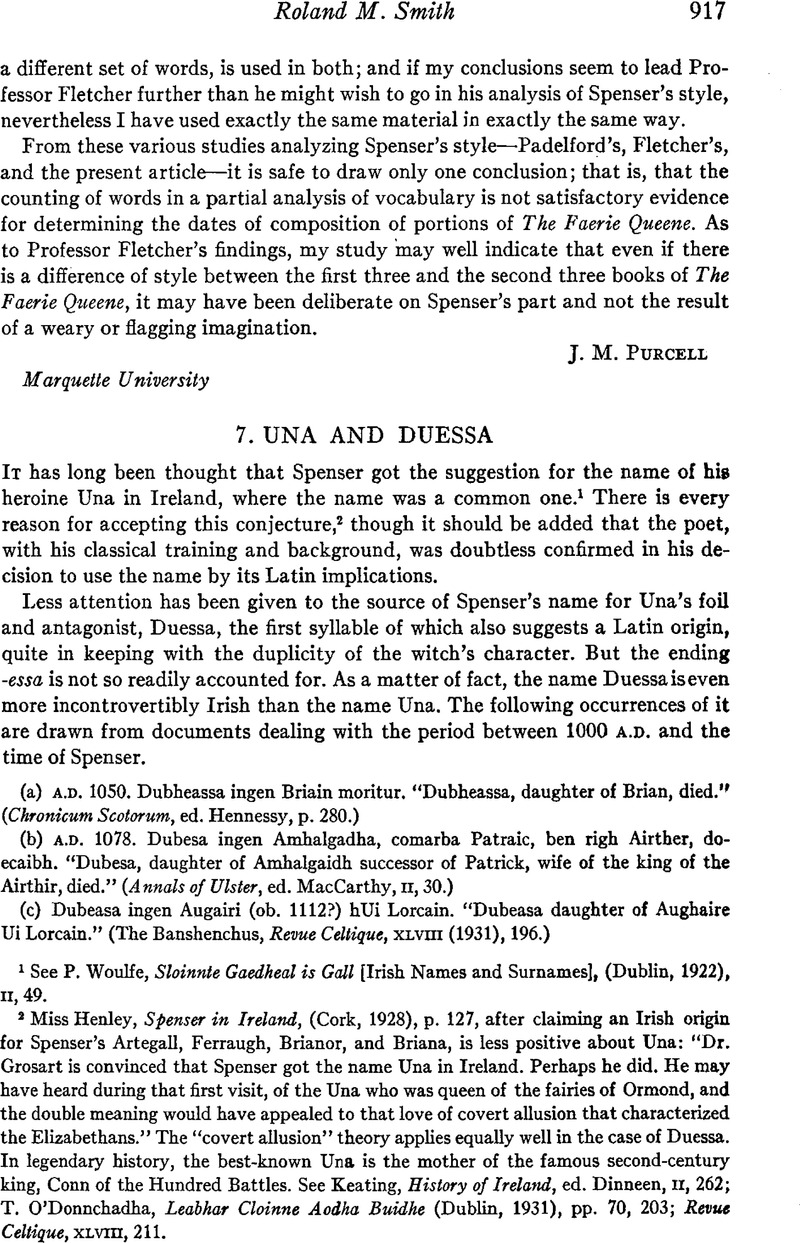Article contents
Una and Duessa
Published online by Cambridge University Press: 02 December 2020
Abstract

- Type
- Comment and Criticism
- Information
- Copyright
- Copyright © Modern Language Association of America, 1935
References
1 See P. Woulfe, Sloinnte Gaedheal is Gall [Irish Names and Surnames], (Dublin, 1922), ii, 49.
2 Miss Henley, Spenser in Ireland, (Cork, 1928), p. 127, after claiming an Irish origin for Spenser's Artegall, Ferraugh, Brianor, and Briana, is less positive about Una: “Dr. Grosart is convinced that Spenser got the name Una in Ireland. Perhaps he did. He may have heard during that first visit, of the Una who was queen of the fairies of Ormond, and the double meaning would have appealed to that love of covert allusion that characterized the Elizabethans.” The “covert allusion” theory applies equally well in the case of Duessa. In legendary history, the best-known Una is the mother of the famous second-century king, Conn of the Hundred Battles. See Keating, History of Ireland, ed. Dinneen, ii, 262; T. O'Donnchadha, Leabhar Cloinne Aodha Buidhe (Dublin, 1931), pp. 70, 203; Revue Celtique, xlviii, 211.
3 On the group of Irish legends in which Ésa figures, see Gwynn's notes on the Dindshenchas of Ráth Ésa (Metrical Dindschenchas, Part ii, 89); also Thumeysen, Die irische Helden- und Königsage, pp. 617–619, 621, 629; Revue Celtique xlviii, 170. In the Banshenchus (Revue Celtique, xlvii, 294 f.) the lines on Ésa are translated (p. 320) as follows: “Ésa was her (Etain's) daughter—evil were her rites [better practices, customs]. Her name is given to a lofty spot, allied by her crimes to pollution. … By her methods manners (bésa!) were coarsened.”
4 Cf. Thurneysen, Handbuch des Alt-Irischen, i, 222; Pedersen, Vergl. Keltische Grammatik, i, 475; ii, 9; Dottin, Manuel d'Irlandais Moyen, i, 57, 106.
5 For Scottish Gaelic see MacBain, Etymological Gaelic Dictionary, s.v. doibheas. See further Windisch, Wörterbuch, Irische Texte, i, s.v. dobus. For the opposite, sobés, “good custom, manners,” cf. Revue Celtique xlv (1928), 88, §16.
6 On the possible identity of Spenser's Irish tutor, see Miss Henley, p. 103. In connection with the poet's possible familiarity with the poetry of his Irish contemporary Tadhg Dall O'Huiginn (p. 107), it is worth noting that Tadhg's poem to Brian O'Rourke refers to the Una who was mother of Conn (cf. note 2 above): Knott, The Bardic Poems of Tadhg Dall O Huiginn, Irish Texts Soc. edition, ii, 73.
7 If Spenser knew, for instance, a tale concerning the “Dubheassa daughter of Brian” (cf. the first entry above), it might help also to explain his slightly disguised names Brianor and Briana.
8 On Spenser's habit of cloaking characters from Irish folklore under the names of their classical counterparts, see my “Spenser's Irish River Stories,” forthcoming in PMLA.
- 1
- Cited by




